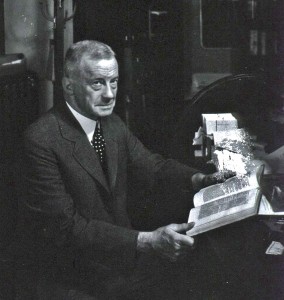A Very Brief History

Fielding H. Garrison, first President of the AAHM (NLM)
The American Association for the History of Medicine had its origins in a small meeting that took place in Washington, D.C. on May 5, 1925. The assembled physicians organized themselves as the American Section of the International Society for the History of Medicine and resolved to meet annually. At the 1927 meeting, historical papers were presented for the first time. The following year the section reconstituted itself as an independent society, the American Association of the History of Medicine. In 1958 the Association adopted its current title, changing the “of” to “for.” Before World War II, the Association was composed almost entirely of physicians with historical or bibliographic interests, and it met in conjunction with a larger medical society, usually at Atlantic City with the Association of American Physicians. The AAHM began to take its current form in 1938 at the urging of Henry Sigerist, who had immigrated from Germany in 1932 to become the Director of the Institute of the History of Medicine at the Johns Hopkins University. Sigerist was the first scholar in the United States to train graduate students in the history of medicine, and as an outlet for scholarship, he had established the Bulletin of the Institute of the History of Medicine. The Association’s new constitution established the Association’s first honorary lectureship, the Fielding H. Garrison Lecture (given for the first time in 1940) and its first two medals, the Osler Medal, awarded for an unpublished paper written by a medical student (first awarded in 1942) and the Welch Medal, awarded for scholarly contributions to the field (first awarded in 1950). Sigerist soon offered to make his journal, renamed the Bulletin of the History of Medicine, the official journal of the American Association of the History of Medicine as well as of the Institute. The arrangement left ownership with Johns Hopkins University and made the Director of the Institute of the History of Medicine the editor, an arrangement which has been in effect ever since.
The AAHM did not hold annual meetings during the war years, 1943-45, although it continued to award the Osler Medal and to publish the Bulletin. In 1947 it began to meet independently of other medical societies and to meet in different cities. By the time of its 25th anniversary, its membership had grown to 578. In the 1960s and 1970s it began to grow more quickly, in part by attracting members with graduate training in history, history of science or medicine or in another of the social sciences, as well as librarians and archivists. By the 50th anniversary in 1975 membership had reached 988, and its annual meetings had larger, more diverse programs with parallel or concurrent sessions. It also sought to recognize and to encourage a wider range of scholarship and other types of scholars with new awards. The Shryock Medal, a second student prize, was awarded for an unpublished essay by a student enrolled in a graduate program in the humanities or social science. It was awarded for the first time in 1984. The Jack D. Pressman Burroughs Wellcome Fund Career Development Award has been awarded since 2000 to recognize a recent Ph.D. who is working to revise her/his dissertation in the area of the history of 20th century medicine or science. The J. Worth Estes Prize is awarded for an article of outstanding merit in the history of pharmacology published in the preceding two years. It was first awarded in 2000. Since 1988 the AAHM has also made a Lifetime Achievement Award to an individual with a distinguished record of support for the history of medicine.
The AAHM has sought to encourage scholarship and teaching in the history of medicine in a variety of ways. Since 1940 it has actively encouraged the formation of constituent societies. A number of other, more specialized societies meet annually with the AAHM. The largest of these is the Sigerist Circle (established in 1990) which encourages the historical focus on issues of class, race, or gender or the use of Marxist, feminist or related critical methodologies. There are also less formal caucuses or interest groups that meet during the annual meetings. These include the clinical historians and the women historians. In some years the AAHM and the American Osler Society meet in the same location in sequence. From 1940 until 1965 the AAHM prepared an annual bibliography of current articles on the history of medicine for publication in the Bulletin of the History of Medicine. Beginning in 1965 that task was assumed by the National Library of Medicine with its print Bibliography of the History of Medicine and subsequently with its on-line bibliographies. The AAHM has also sponsored several studies of the current state of teaching medical history in North American medical schools and of graduate programs in the history of medicine. These have resulted in important published reports. The Association has not forgotten its roots in the International Society for the History of Medicine, It continues to send an official delegate to the international meetings, and individual members also attend.
Currently the AAHM continues to hold annual meetings with rich and diverse programs of papers, luncheon workshops, less formal interest group meetings, and ample time for conversation among members with shared historical interests. Current membership exceeds 1,000 with attendance at annual meeting between 400 and 450. The Association prides itself in fostering a congenial environment for the presentation of scholarly work and for discussion and debate, and in recognizing and encouraging historical research and interpretation of the highest quality.
